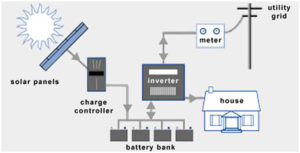 Grid-tied systems can be upgraded to include a battery backup: a bank of deep-cycle batteries. The backup battery is charged by both the grid and the solar panels. In the event of an outage, the backup battery will need to be switched on either manually or with an automatic system to provide backup power to the building.
Grid-tied systems can be upgraded to include a battery backup: a bank of deep-cycle batteries. The backup battery is charged by both the grid and the solar panels. In the event of an outage, the backup battery will need to be switched on either manually or with an automatic system to provide backup power to the building.
Panels
- PV panels, which cost anywhere from $2.40 per watt to over $5 per watt, are the single biggest expense of a PV system. Their placement and mounting affect your system performance more than any other facet of the job.
Mounting Equipment
- Mounting your PV panels is of critical importance. First, you need to mount the panels where they’ll get maximum sunshine over the course of a year. But the more difficult problem is to mount them with enough integrity that they’ll stay put for 25 years or more.
DC-to-AC inverters
- Inverters take the low-voltage, high-current signals from the PV panels and convert them into 120VAC (or 240 VAC), which is directly compatible with grid power. Inverters cost around $0.70 per watt, or around $2,600 for a typical application. From a reliability standpoint, they are generally the weak link in any PV system, so quality is a must.
Tracking Mounts
- Tracking mounts mechanically move the PV panels over the course of a day so that they directly face the sun at all times. Dual axis trackers change both azimuth and elevation, while single axis trackers only match the azimuth.
Disconnect Switches
- Disconnect switches are of critical importance, and they need to be mounted within easy reach. Every member of your family should know exactly how to turn the PV system off for safety reasons. If any abnormal behavior occurs in your home’s electrical system, shut off the solar system first.
Wiring and Fuse Box Connections
- Wiring, conduit, and connections to your household main fuse box are minor hardware expenses, but they comprise a big chunk of the labor when you’re installing a PV system.
Battery Bank
- To make system active by provide battery backup when On-Grid solar system is OFF. This backup can be design up to requirement and few hour to 24 hours. This battery bank charge by charger & controller and discharge by inverter provided in this system.
Utility Power Meters
- Conventional power meters are capable of spinning backward, but utility companies usually change to a special digital meter when you connect to the grid because most solar customers go to the TOU (time-of-use) rate structure, which requires more intelligent processing than a mechanical device is capable of.
